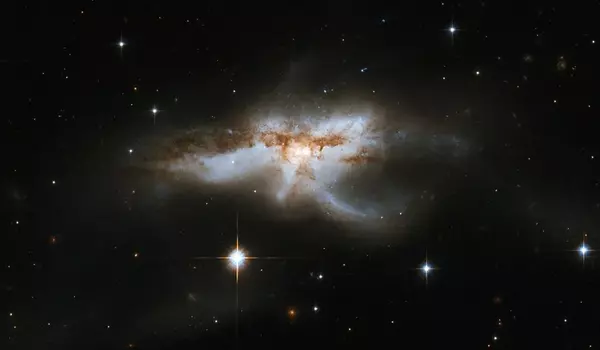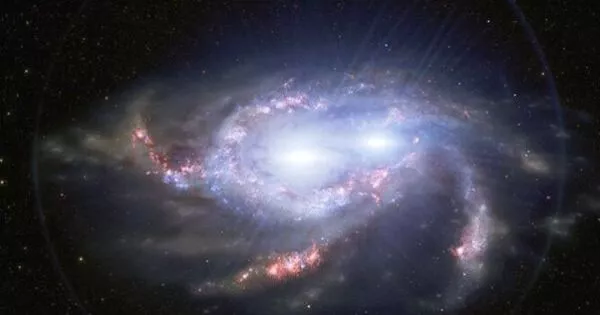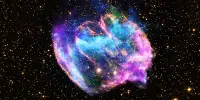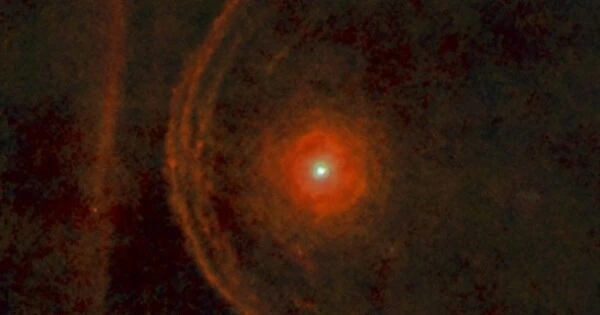Scientists have discovered a pair of supermassive black holes located in a nearby galaxy merger. These black holes are thought to be in the process of merging into a single, larger black hole. This discovery provides important new insights into the formation and evolution of supermassive black holes in galaxies. The study of these black holes can help scientists understand the dynamics of galaxy mergers and the growth of black holes over time.
While studying a nearby pair of merging galaxies with the Atacama Large Millimeter/submillimeter Array (ALMA), an international observatory co-operated by the National Science Foundation’s National Radio Astronomy Observatory (NRAO), scientists discovered two supermassive black holes growing simultaneously near the center of the newly merging galaxy. These super-hungry giants are the closest scientists have ever observed in multiple wavelengths. Furthermore, the new research suggests that binary black holes and the galaxy mergers that create them are surprisingly common in the Universe. The findings of the new study were published today in The Astrophysical Journal Letters and presented at a press conference at the 241st meeting of the American Astronomical Society (AAS) in Seattle, Washington.
UGC4211 is an ideal candidate for studying the end stages of galaxy mergers, which occur more frequently in the distant Universe and, as a result, can be difficult to observe. It is only 500 million light-years away from Earth in the constellation Cancer. When scientists used ALMA’s highly sensitive 1.3mm receivers to peer deep into the merger’s active galactic nuclei – compact, highly luminous areas in galaxies caused by matter accretion around central black holes – they discovered not one, but two black holes gluttonously devouring the merger’s byproducts. Surprisingly, they were dining next to each other with only 750 light-years between them.
This fascinating discovery demonstrates ALMA’s power and how multi-wavelength astronomy can generate important results that expand our understanding of the universe, such as black holes, active galactic nuclei, galaxy evolution, and more.
Joe Pesce
“Simulations suggested that most of the population of black hole binaries in nearby galaxies would be inactive because they are more common, not two growing black holes like we found,” said Michael Koss, a senior research scientist at Eureka Scientific and the lead author of the new research.
Koss went on to say that the use of ALMA was a game changer, and that discovering two black holes so close together in the nearby Universe could pave the way for further research into the exciting phenomenon. “ALMA is unique in that it can see through large columns of gas and dust while achieving extremely high spatial resolution to see objects that are very close together. Our research found one of the closest pairs of black holes in a galaxy merger, and since galaxy mergers are much more common in the distant Universe, these black hole binaries may be much more common than previously thought.”
If close-paired binary black hole pairs are indeed commonplace, as Koss and the team posit, there could be significant implications for future detections of gravitational waves.

Ezequiel Treister, an astronomer at Universidad Católica de Chile and a co-author of the research said, “There might be many pairs of growing supermassive black holes in the centers of galaxies that we have not been able to identify so far. If this is the case, in the near future we will be observing frequent gravitational wave events caused by the mergers of these objects across the Universe.”
Combining ALMA data with multi-wavelength observations from powerful telescopes such as Chandra, Hubble, ESO’s Very Large Telescope, and Keck enhanced an already compelling story. “Each wavelength represents a different aspect of the story. While optical imaging from the ground revealed the entire merging galaxy, Hubble revealed the nuclear regions at high resolution. X-ray observations revealed that the system contained at least one active galactic nucleus “Treister stated. “And ALMA pinpointed the precise location of these two expanding, hungry supermassive black holes. All of these data have provided us with a clearer picture of how galaxies like our own came to be the way they are, and what they will become in the future.”
So far, scientists have mostly studied only the earliest stages of galaxy mergers. The new research could have a profound impact on our understanding of the Milky Way Galaxy’s own impending merger with the nearby Andromeda Galaxy. Koss said, “The Milky Way-Andromeda collision is in its very early stages and is predicted to occur in about 4.5 billion years. What we’ve just studied is a source in the very final stage of collision, so what we’re seeing presages that merger and also gives us insight into the connection between black holes merging and growing and eventually producing gravitational waves.”
“This fascinating discovery demonstrates ALMA’s power and how multi-wavelength astronomy can generate important results that expand our understanding of the universe, such as black holes, active galactic nuclei, galaxy evolution, and more,” says Joe Pesce, NSF program director for the National Radio Astronomy Observatory. “With the advent of gravitational wave detectors, we now have the opportunity to further expand our observational capabilities by combining all of these capabilities. I don’t believe there is a limit to what we can learn.”
















